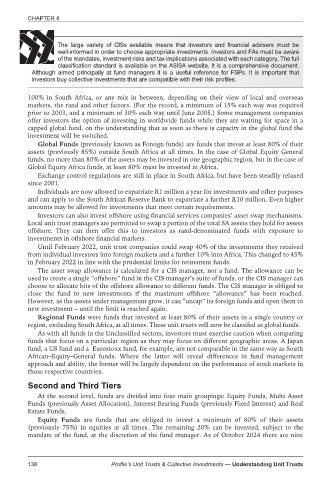Page 140 - Profile's Unit Trusts & Collective Investments - March 2025
P. 140
CHAPTER 8
The large variety of CISs available means that investors and financial advisers must be
well-informed in order to choose appropriate investments. Investors and FAs must be aware
of the mandates, investment risks and tax implications associated with each category. The full
classification standard is available on the ASISA website. It is a comprehensive document.
Although aimed principally at fund managers it is a useful reference for FSPs. It is important that
investors buy collective investments that are compatible with their risk profiles.
100% in South Africa, or any mix in between, depending on their view of local and overseas
markets, the rand and other factors. (For the record, a minimum of 15% each way was required
prior to 2003, and a minimum of 30% each way until June 2005.) Some management companies
offer investors the option of investing in worldwide funds while they are waiting for space in a
capped global fund, on the understanding that as soon as there is capacity in the global fund the
investment will be switched.
Global Funds (previously known as Foreign funds) are funds that invest at least 80% of their
assets (previously 85%) outside South Africa at all times. In the case of Global Equity General
funds, no more than 80% of the assets may be invested in one geographic region, but in the case of
Global Equity Africa funds, at least 80% must be invested in Africa.
Exchange control regulations are still in place in South Africa, but have been steadily relaxed
since 2001.
Individuals are now allowed to expatriate R1 million a year for investments and other purposes
and can apply to the South African Reserve Bank to expatriate a further R10 million. Even higher
amounts may be allowed for investments that meet certain requirements.
Investors can also invest offshore using financial services companies’ asset swap mechanisms.
Local unit trust managers are permitted to swap a portion of the total SA assets they hold for assets
offshore. They can then offer this to investors as rand-denominated funds with exposure to
investments in offshore financial markets.
Until February 2022, unit trust companies could swap 40% of the investments they received
from individual investors into foreign markets and a further 10% into Africa. This changed to 45%
in February 2022 in line with the prudential limits for retirement funds.
The asset swap allowance is calculated for a CIS manager, not a fund. The allowance can be
used to create a single “offshore” fund in the CIS manager’s suite of funds, or the CIS manager can
choose to allocate bits of the offshore allowance to different funds. The CIS manager is obliged to
close the fund to new investments if the maximum offshore “allowance” has been reached.
However, as the assets under management grow, it can “uncap” its foreign funds and open them to
new investment – until the limit is reached again.
Regional Funds were funds that invested at least 80% of their assets in a single country or
region, excluding South Africa, at all times. These unit trusts will now be classifed as global funds.
As with all funds in the Unclassified sectors, investors must exercise caution when comparing
funds that focus on a particular region as they may focus on different geographic areas. A Japan
fund, a US fund and a Eurostoxx fund, for example, are not comparable in the same way as South
African–Equity–General funds. Where the latter will reveal differences in fund management
approach and ability, the former will be largely dependent on the performance of stock markets in
those respective countries.
Second and Third Tiers
At the second level, funds are divided into four main groupings: Equity Funds, Multi Asset
Funds (previously Asset Allocation), Interest Bearing Funds (previously Fixed Interest) and Real
Estate Funds.
Equity Funds are funds that are obliged to invest a minimum of 80% of their assets
(previously 75%) in equities at all times. The remaining 20% can be invested, subject to the
mandate of the fund, at the discretion of the fund manager. As of October 2024 there are nine
138 Profile’s Unit Trusts & Collective Investments — Understanding Unit Trusts

